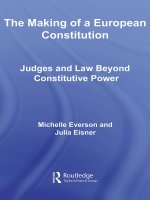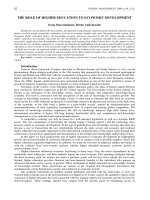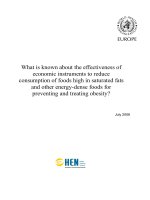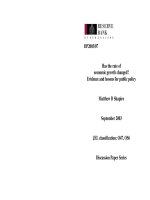The relationship of interrogative suggestibility to memory and attention
Bạn đang xem bản rút gọn của tài liệu. Xem và tải ngay bản đầy đủ của tài liệu tại đây (3.82 MB, 241 trang )
THE RELATIONSHIP OF
INTERROGATIVE SUGGESTIBILITY TO
MEMORY AND ATTENTION
APITCHAYA CHAIWUTIKORNWANICH
NATIONAL UNIVERSITY OF SINGAPORE
2005
THE RELATIONSHIP OF
INTERROGATIVE SUGGESTIBILITY TO
MEMORY AND ATTENTION
APITCHAYA CHAIWUTIKORNWANICH
(B.Ed., M.A, Chulalongkorn university, Thailand)
A THESIS SUBMITTED
FOR THE DEGREE OF DOCTOR OF PHILOSOPHY
DEPARTMENT OF SOCIAL WORK AND PSYCHOLOGY
NATIONAL UNIVERSITY OF
SINGAPORE
2005
ii
Acknowledgements
Special thanks to:
God: For answering my prayers and for everything that I have had gone through.
Chulalongkorn University: my main sponsor, for allowing me to come here.
A/P Richard Howard: my supervisor, for your kind opportunities, ideas, support,
guidance, supervision, editing and everything. Without you, I cannot have this thesis.
You are very kind to me. You are my great supporter. Dr. Steven Graham: my co-
supervisor, for your ideas, suggestions and editing. Department of Social Work and
Psychology, NUS: For two semester academic fee waiver and conference subsidization.
A/P Ngiam Tee Liang, A/P Chua Fook Kee for your opportunities and kind concern. Prof.
Ramadah Singh, Dr. Mark Barlette for your academic suggestions and your moral
support. Prof. George Bishop, Dr. Elizabeth Nair for allowing me to attend your courses.
Mr. Paul Leong for solving computer problems. Mr. Wai Yen for solving technical
problems during my data analysis and statistics consultation. Ms. Susheel Kaur, for moral
support. Experts at Biosemi and Brain Analyzer companies, including experts of Wesp
stimulus presentation: For your technical help. You always answered my questions
quickly. Participants: You were very cooperative, paid good attention to my experiments.
Friends: my postgraduate friends. For your company, discussion, and emotional support.
You made my life here enjoyable. Ms. Caroline Lim for explaining me how to analyze
data with the old equipment. Mr. Joshua Goh for your help and being a good friend. My
housemates, for broadening my world and emotional support. My family: my parents, my
husband, and my brother and sister, for all kinds of support.
iii
Table of Contents
Title Page…………………………………………………………………………. i
Acknowledgements………………………………………………………………. ii
Table of Contents………………………………………………………………… iii
Summary…………………………………………………………………………. viii
List of Tables…………………………………………………………………… iv
List of Figures……………………………………………………………………. xi
List of Abbreviations…………………………………………………………… xiii
Preamble………………………………………………………………………… 1
Chapter 1 Introduction: Interrogative Suggestibility…………………………… 3
Definition of false confession……………………………………………. 4
Different types of false confessions……………………………………… 4
The definition of Interrogative Suggestibility (IS)……………………… 5
The individual differences approach to Interrogative Suggestibility…… 7
: The Gudjonsson-Clark Theoretical model……………………… 7
: Discrepancy detection…………………………………………… 9
Different types of Suggestibility………………………………………… 10
Features of interrogative suggestibility that distinguish IS from other types
of suggestibility…………………………………………………………. 12
The measurement of Interrogative Suggestibility………………………… 12
The Gudjonsson Compliance Scale (GCS)………………………………. 13
Correlations between interrogative suggestibility and other variables…… 15
EEG and ERPs……………………………………………………………. 22
-Artifacts……………………………………………………………… 24
-Peak and Latency measurement…………………………………… 25
-ERP components……………………………………………………… 25
Overview of Memory…………………………………………………… 31
Studies of encoding………………………………………………………. 33
Studies of retrieval……………………………………………………… 34
-Dual process theories of recognition memory…………………… 34
ERPs studies of memory: (i) Studies of encoding……………………… 36
iv
ERPs studies of memory: (i) Studies of retrieval………………………… 37
-ERPs and implicit memory…………………………………………… 37
-ERPs and explicit memory…………………………………………… 37
-ERPs and Recognition Memory:
Dissociating Familiarity and Recollection…………………………… 37
Familiarity assessment……………………………………………… 38
Recollection………………………………………………………… 39
Late right frontal old/new effects…………………………………… 41
-Mecklinger’s (2000) Neurocognitive Model of Recognition Memory 43
Neuroanatomy of memory………………………………………………… 44
False recognition and ERPs………………………………………………. 46
An Overview of attention……………………………………………. 48
ERPs and visuo-spatial attention…………………………………………. 50
ERPs and attention in Oddball tasks……………………………………… 51
Attention, ERP, and interrogative suggestibility…………………………. 52
Research questions……………………………………………………… 53
Main Hypotheses…………………………………………………………. 55
Chapter 2 Methods……………………………………………………………… 57
Overall Study Design and Procedure…………………………………… 59
Methods and measures…………………………………………………… 62
1. Interrogative Suggestibility measures……………………………… 62
Gudjonsson Suggestibility Scale Paradigm………………………… 62
-GSS free recall…………………………………………………… 65
2. Non-GSS Memory Measures………………………………………… 65
The Post-Event Memory Questionnaire (PEMQ)…………………… 65
False recognition……………………………………………………. 66
The Deese-Roediger McDermott list learning paradigm (DRM)…… 67
3. Performance Measures……………………………………………… 68
Oddball task: its reaction time and accuracy……………………… 68
4. Personality Measures……………………………………………… 69
The Gudjonsson Compliance Scale (GCS)………………………… 69
v
Five Factor Model of Personality…………………………………… 70
5. ERP and their measurement………………………………………… 72
Purpose of the ERP study……………………………………………. 72
Procedure………………………………………………………………… 73
Study1…………………………………………………………………. 73
Participants………………………………………………………… 73
Memory Measurement……………………………………………… 73
ERP and GSS measurement………………………………………… 75
Stimulus material and presentation…………………………………. 77
Task paradigm………………………………………………………. 78
EEG recording………………………………………………………. 79
Behavioural recording………………………………………………. 79
The reason for conducting Study 2……………………………………… 79
Study 2………………………………………………………………… 80
Participants………………………………………………………… 80
ERP measurement and procedure…………………………………… 81
Data analyses………………………………………………………… 81
-Memory, suggestibility, oddball performance and personality analysis 81
-ERP data analyses…………………………………………………… 84
ERP analyses of memory………………………………………… 89
ERP analyses of memory following Mecklinger’s (2000) model…. 90
ERP analyses of attention………………………………………… 90
Chapter 3 Result1: Memory and task performance……………………………… 92
Specific research questions……………………………………………… 92
Hypotheses………………………………………………………………. 92
Results: Memory, Interrogative Suggestibility, and Oddball task
performance…………………………………………………… 96
Overall results: DRM, GCS, and PEMQ………………………………. 96
Results for DRM and GCS compared males and females……………… 101
DRM, GSS suggestibility and memory, compared between
GSS1 & GSS2, males & females…………………………………… 103
vi
Intercorrelations for Interrogative Suggestibility and memory………… 105
Oddball performance (reaction time and accuracy)……………………. 112
Between males and females vs.between GSS1 and GSS2…………… 112
Between groups of suggestibility and DRM measures……………… 115
Summary of Results and Discussion……………………………………… 119
Chapter 4 Result 2: Personality Correlates of Interrogative Suggestibility………. 123
Results and Discussion……………………………………………………. 123
Chapter 5 Result 3: ERP indices of memory in relation to
individual differences in interrogative suggestibility……… 130
Results: ERP old/new effects, Memory and Interrogative Suggestibility… 130
ERP old/new effects following Mecklinger’s paradigm………………… 159
Summary of Results and Discussion………………………………………. 162
Chapter 6 Result 4: ERP Indices of attention: their relationship to
individual differences in interrogative suggestibility……… 165
Conclusions and Discussion……………………………………………… 169
Chapter 7 Discussion and Conclusions…………………………………………. 170
Interrogative suggestibility and memory………………………………… 170
Interrogative suggestibility, memory, and attention: ERP old/new effects 171
Interrogative suggestibility and memory following
Mecklinger’s (2000) model……………………………………………… 175
Interrogative suggestibility and personality……………………………… 177
Some outstanding questions and directions for future research…………… 178
Limitations of the present study…………………………………………… 180
Concluding remarks……………………………………………………… 181
Bibliography………………………………………………………………………. 183
Appendices
Appendix A GSS stories and questions…………………………………. 205
Appendix B GCS (Form D)…………………………………………… 207
Appendix C The PEMQ………………………………………………… 208
Appendix D The DRM words and questionnaire………………………. 210
Appendix E Five Factor Personality questionnaire…………………… 216
vii
Appendix F Stimuli in the oddball paradigm………………………… 219
Appendix G Instructions……………………………………………… 221
Appendix H Examples of the questionnaire for GSS comparison…… 223
Appendix I Standardization of the GSS scales……………………… 224
viii
Summary
This study combined an individual differences approach to interrogative
suggestibility (IS) using various paradigms (GSS, DRM, PEMQ) and questionnaires
(free recall, recognition, and five-factor personality), including Event Related Potential
(ERP) recordings to examine two alternative hypotheses regarding the source of
individual differences in IS: (i) differences in attention to task-relevant vis-à-vis task-
irrelevant stimuli; (ii) differences in one or more memory process, indexed by ERP
old/new effects. Participants (N=405) were screened, and those with extremely low or
high suggestibility went on to participate in the ERP experiment. Ninety-seven
participants underwent an ERP recording during the 50 min. interval between
immediate and delayed recall of a short story. ERPs elicited by pictures that either
related to (“old”), or did not relate to (“new”) the story were recorded using a 3-
stimulus visual oddball paradigm. ERP old/new effects were examined at selected scalp
regions of interest at three intervals post-stimulus: early (250-350 ms), middle (350-700
ms) and late (700-1100 ms). Attention-related ERP components (N1, P2, N2 and P3)
evoked by story-relevant pictures, story-irrelevant pictures, and irrelevant distractors
were measured from midline ERP electrodes. Differences in IS were reflected in late
right prefrontal old/new differences, while differences in memory and task performance
were reflected in early and middle latency old/new differences. Results supported an
account of individual differences in IS as reflecting post-retrieval memory processes
rather than attentional processes. In addition, it was shown that neurotic introverts
tended to be more compliant.
ix
List of Tables
Table 1 Mecklinger’ s (2000) Neurocognitive Model of 43
Recognition Memory
Table 2 Glossary of memory and performance measure 58-59
and their abbreviations
Table 3 Ranges of the scores for low and high groups of 83
GSS1 and GSS2 of Study1 and Study 2
Table 4 Numbers of trials that were used for ERP averages 86-87
in each condition
Table 5 Descriptive statistics of the variables 96
Table 6 Rotated Component Matrix of the variables 97
Table 7 Pearson correlations between the variables 98
Table 8 Rotated Component Matrix of Study 1 variables 100
Table 9 Means and standard errors of males and females 101
for memory and suggestibility
Table 10 Pearson correlations between the variables of females 102
Table 11 Pearson correlations between the variables of males 102
Table 12 GSS and DRM behavioural measures 104-105
Table 13 Pearson correlations between the variables of GSS1 106
Table 14 Pearson correlations between the variables of GSS2 108
Table 15 Pearson correlations between the variables of collapsed 110
GSS1 and GSS2
Table 16 Pearson correlations between five factor personality variables 124
and the variables of interest of collapsed GSS1 and GSS2
Table 17 Pearson correlations between five factor personality variables 125
and the variables of interest of GSS1
Table 18 Pearson correlations between five factor personality variables 126
x
and the variables of interest of GSS2
Table 19 Summary of ANOVA results: 139
2 (conditions) x 7 (regions) x 2 (sex) x 2 (GSS)
Table 20 Summary of ANOVA results: 141
2 (conditions) x 7 (regions) x 2 (GSS)
Table 21 Significance level of ANOVA results at each region 146
of interest of three intervals of interest
Table 22 Summary of results of 161
2 (conditions) x 2 (GSS) x 2 (groups) ANOVAs
following Mecklinger’s model
xi
List of Figures
Figure 1 A Theoretical model of interrogative suggestibility 8
Figure 2 ERP main components 26
Figure 3 Procedure of the present study 61
Figure 4 Montage for EEG recordings, with grand average 89
of Condition 1
Figure 5 Oddball performance data (accuracy) 113
compared GSS1 and GSS2, separately
for males and females
Figure 6 Reaction Times of Condition 2 (hit) 114
and Condition 3 (CR) Compared between
GSS1 and GSS2, separately for males and females
Figure 7 Participants’ rating of picture recognition 118
compared between GSS1 and GSS2
(conducted in New Zealand)
Figure 8 a. Topographical maps (old-new) of overall participants 131
b. Old/new effects at each region of interest 132
Figure 9 a. Scalp topography compared females and males 133
b. Old/new grand averages at each region of interest 134-135
compared between males and females
Figure 10 a. Scalp topography compared GSS1 and GSS2, 136
males and females combined
b. Old/new grand average at each region of interest 137-138
compared between GSS1 and GSS2
Figure 11 Topographical maps of females, GSS1 and GSS2 140
combined
Figure 12 a. Scalp Topography of separate GSS1 and GSS2 of females 142
b. ERP old/new effects of female participants who underwent 143-144
GSS1 and GSS2
xii
Figure 13 a. Scalp topography of low and high 148
Total Suggestibility (TS) individuals
of collapsed GSSs
b. ERP old/new effects at regions and intervals 149-150
of interest in grouping of Total Suggestibility
of collapsed GSS1 and GSS2
Figure 14 a. Scalp topography of low and high 151
DRM-free recall (RW) individuals
of collapsed GSS1 and GSS2
b. ERP old/new effects of low and high 152-153
DRM-free recall (RW) individuals
of collapsed GSS1 and GSS2
Figure 15 a. Scalp topography and old-new effects of low and high 154
FA(oddball) individuals of collapsed GSS1 and GSS2
b. ERP old/new effects of low and high FA(oddball) 155-156
individuals of collapsed GSS1 and GSS2
Figure 16 Scalp topography and old-new effects 157
of low and high RW individuals of GSS1
Figure 17 Scalp topography and old-new effects 157
of low and high RW individuals of GSS2
Figure 18 Scalp topography and old-new effects 158
of low and high FA(oddball) individuals of GSS1
Figure 19 Scalp topography and old-new effects 158
of low and high FA(oddball) individuals of GSS2
Figure 20 ERP old/new effects of overall participants 159-160
following Mecklinger’s (2000) model
Figure 21 Peak amplitudes of each epoch 166
Figure 22 ERP grand averages of low and high TS individuals 168-169
of collapsed GSS1 and GSS2 for the midline sites
of three conditions
xiii
List of Abbreviations
ANOVA
Analysis of variance
C Condition in the three stimulus oddball paradigm in
which there are three conditions, Condition1 (C1);
geometric shape, Condition2 (C2); relevant-to-the-
story/old pictures, and Condition3 (C3); irrelevant-
to-the-story/new pictures
Ch Channel; ERP electrode sites
CR Correct Rejection: story-irrelevant/new pictures
correctly identified as such
De-Re, De-Recall Delayed recall from the Gudjonsson Suggestibility
Scale paradigm
DRM paradigm/questionnaire The Deese, Mc-Dermott-Roediger
paradigm/questionnaire
DRM-FA, FA-DRM False Alarm from the Deese, McDermott-Roediger
paradigm; critical lures falsely recognized as old
FA (oddball), FA-oddball False Alarm from the oddball paradigm: story-
irrelevant/new pictures incorrectly identified as
story-relevant/old pictures
GCS Gudjonsson Compliance Scale
GSS Gudjonsson Suggestibility Scale paradigm which
have two versions, GSS1 and GSS2
Hit Correct Recognition: story-relevant/old pictures
correctly identified as such
Im-Re, Im-Recall Immediate recall from the Gudjonsson
Suggestibility Scale paradigm
IS Interrogative Suggestibility
Miss Incorrect rejection: story-relevant/old pictures
incorrectly identified as story-irrelevant/new
xiv
Mislead, Misleading Misleading questions in the Post-Event Memory
Questionnaire paradigm
MDS Memory Distrust Syndrome
ms millisecond
MTL Medial Temporal Lobe
N Numbers of participants
New Participants circled correctly “new” words as “new”
in the DRM questionnaire.
New2 Participants circled correctly “new” words as “new”
in the other form of the DRM questionnaire.
Old Participants circled correctly “old” words as “old”
in the DRM questionnaire.
Old2 Participants circled correctly “old” words as “old”
in the other form of the DRM questionnaire.
PEMQ The Post-Event Memory Questionnaire
Repeat Repeated questions in the PEMQ paradigm
RT Reaction Time
RW, DRM-free recall Recall Word, free recall from the DRM paradigm
SD Standard Deviation
SE Standard Error
Shift Participants shifted their answers after the negative
feedback
Specific Specific questions in the PEMQ paradigm
TS Total Suggestibility which is the sum of Yield1 and
shift
Yield1 Participants yielded to the leading questions in the
Gudjonsson Suggestibility Scale paradigm
xv
Yield2 Participants yielded to the leading questions in the
Gudjonsson Suggestibility Scale paradigm after the
negative feedback
OF Orbitofrontal region
FC Fronto-central region
CP Centro-parietal region
LPF Left prefrontal region
RPF Right prefrontal region
LTP Left temporo-parietal region
RTP Right temporo-parietal region
1
Preamble
False confessions can put innocent people to jail. There are various factors that
influence accuracy in the process of confessions. One of these factors is the suggestive
interviewing techniques. The suggestive interviewing techniques have a high risk of
tainting individuals’ testimony which has long been realized and accepted by courts of
law. However, reliable information about the types of people who are most likely to be
tainted by suggestive interviewing has not been established (Bruck & Melnyk, 2004). The
correlations between suggestibility and psycho-social (e.g. self-concept, compliance) and
cognitive (e.g. intelligence, memory) factors, as reviewed by Bruck and Melnyk (2004),
are reported to be inconsistent. Some studies found significant correlations; others did not.
Even worse, there were significant correlations in unexpected ways. Lee (2004) found
that better verbal paired associates memory can be correlated with either higher or lower
suggestibility depending on the paradigms used to measure suggestibility.
With the contradictions mentioned above, the present study would like to explore
the relationship between interrogative suggestibility and memory/attention using ERPs
(event-related potentials) to illustrate the ERP differences of low and high individuals of
interrogative suggestibility measured by a well-accepted Gudjonssons Suggestibility
scales (GSS). The exploration comprised two studies due to thesis development. Study 1
used the PEMQ paradigm (Post-Event Memory Questionnaire; Eisen, Morgan, & Mickes,
2002) to screen participants of supposed-to-be low and high suggestible individuals to
participate in the GSS paradigm and the ERP measurement. However, from Study 1,
there were a small number of participants to be analyzed for ERPs and the correlations of
the misleading questions of the PEMQ paradigm and the Yield score of GSS scales were
2
less positively correlated than the correlations of the false alarm to lure score of the DRM
paradigm (DRM-FA; Deese-Roediger, McDermott list learning paradigm; Deese, 1959
and Roediger & McDermott, 1995) and the Yield score of GSS scales. Therefore, Study 2
was conducted using the DRM-FA instead of the misleading questions of the PEMQ
paradigm to screen participants of supposed-to-be low and high suggestible individuals to
participate in the GSS paradigm and the ERP measurement. For data analyses, due to the
same procedures of ERP and GSS measurements except only for the preliminary
screening process of participants, the two studies were collapsed and analyzed as one.
This thesis has been organized into 7 chapters. Chapter 1, Introduction, the
involved literature, namely, Interrogative Suggestibility (IS), ERPs, memory, attention,
and the linkages among the mentioned variables including research questions and
hypotheses will be presented. Chapter 2, the methodology of the studies will be described,
focusing on (i) cognitive/behavioural measures and (ii) ERP measures. This will be
followed, in Chapter 3, by Result 1: Memory and Task Performance and, in Chapter 4, by
Result 2: Some Personality correlates of IS. Chapter 5 will present results from the
present study pertaining to memory, ERPs, and IS. Chapter 6 will present results from the
present study pertaining to attention, ERPs and IS. Finally, Chapter 7 will present an
overall discussion of the results.
It was hoped that findings from the present study might shed some light on the
brain mechanisms that produce individual differences in Interrogative Suggestibility.
Such knowledge would give us a better understanding of not just who, but more
importantly why, some people are likely to give false confessions which are still a major
issue in legal contexts.
3
Chapter 1
Introduction
Prologue:
This chapter offers reviews of findings related to interrogative suggestibility (IS),
EEG (Electroencephalogram), ERPs (Event-Related Potentials), memory and attention
followed by a statement of research questions and hypotheses addressed in this thesis.
Since the importance of IS in legal/forensic contexts lies in its relationship to false
confessions, this review will start with an outline of findings related to confessions in a
legal context.
Confessions
Confessions are crucial processes in the legal system. Many studies have been
conducted to find out why people confess (e.g. Gudjonsson & Sigurdsson, 1999;
Gudjonsson & Petursson, 1991). There are many factors that are related to proneness to
confess. Suspects confess due to a combination of factors, rather than to one factor
(Gudjonsson, 2003). However, some suspects confess to a crime that they are really
innocent of, which is called “false confession”. False confessions are important because
they can lead to wrongful convictions. As a result, innocent people are punished for a
crime they have not committed. False confessions can occur frequently and are difficult
to detect (Gudjonsson & Sigurdsson, 1994).
Gudjonsson and Sigurdsson (1994) conducted a study to see how frequently false
confessions occur. He found that female prisoners claimed to have made more false
confessions than males. The reasons for making false confessions were to protect
someone else from being prosecuted (48%) or because of police pressure or to avoid a
4
prison sentence (52%). Most of them (78%) had never retracted the confession, stating
that they had seen no point to do so. In addition, the majority of them (78%) were
convicted of the crime to which they had made a false confession.
Definitions of false confession
Ayling (1984) suggests that there are two ways of defining false confession.
Firstly, there are cases where the persons are totally innocent. They have not known
anything about the crime. Secondly, there are cases where the persons overstate their
involvement in the crime. Ayling (1984) suggests that overstating involvement in the
crime is much more common than confessing to a crime that the individual is not
involved in at all; however, he does not provide data to support his claim.
Different types of false confessions
There are many causes of false confession. Kassin and Wrightsman (1985)
defined three types of false confession. Firstly, voluntary false confession where the false
confession is offered voluntarily by an individual, without police pressure. According to
Kassin and Wrightsman (1985), this may be due to a pathological need to become
infamous, an unconscious need to relieve guilt via self-punishment, inability to
distinguish facts from fantasy, or a desire to protect the real offender, and so on.
Secondly, coerced-compliant false confession which results from the pressure or
coerciveness of the interrogation process; for example, the confessor may want to escape
from the interrogation, bringing the interview to an end. Thirdly, coerced-internalized
false confession which occurs when suspects come to believe that they have committed
the crime, although they have no actual memory of the crime. Gudjonsson (2003)
invoked IS as the cause of this kind of false confession. Gudjonsson and MacKeith (1982,
5
cited in Gudjonsson, 2003) further stated that this kind of confession came from a
Memory Distrust Syndrome (MDS) which they defined as “a condition where people
develop profound distrust of their memory recollections, as a result of which they are
particularly susceptible to relying on external cues and suggestions (p.196)”.
Gudjonsson (2003) stated that there were two types of MDS. Firstly, it may
result from amnesia or alcohol induced memory problem. Secondly, suspects may, at the
beginning of the police interview, have a clear recollection of not having committed the
offence, but later come to distrust their recollections as a result of subtle interrogation.
As stated by Gudjonsson (2003), a phenomenon that causes false confessions,
particularly of the coerced-internalized type, is Interrogative Suggestibility (IS).
The definition of IS
The idea of IS has its origin in the work of the French psychologist Binet, who
some 75 years before the phenomenon of false memories was re-discovered, described a
series of studies in which he manipulated, and measured IS in school children (Binet,
1900). Binet described two types of memory errors: logical errors, and errors of the
imagination. According to Binet, errors of the imagination arise when individuals
construct an object that is not real. Garry, Manning, Loftus, and Sherman (1996) referred
to this confidence-inflating effect of the imagination as “imagination inflation”. Later,
Powers, Andriks, and Loftus (1979) defined IS as “… the extent to which they (people)
come to accept a piece of post-event information and incorporate it into their recollection
(p.339)”. According to Gudjonsson (2003), this definition is too vague and it has not been
proven whether or not the individual incorporated the suggested information into their
6
recollection, even though they seemed to accept it. Gudjonsson and Clark (1986)
provided the following, more focused definition:
“The extent to which, within a closed social interaction, people come to accept
messages communicated during formal questioning, as the result of which their
subsequent behavioural response is affected (p.84)”.
Gudjonsson (2003) states that this definition comprises five interrelated
components of IS process which are:
1. a social interaction
2. a questioning procedure
3. a suggestive stimulus
4. acceptance of the stimulus
5. a behavioural response, such as a verbal reply to the question asked.
In police interviews, the interview is a closed social interaction, involving the
interviewer and the interviewee. Interruptions are avoided as much as possible (Irving,
1980 cited in Gudjonsson, 2003). This means that the police interview process can easily
induce suggestibility through the use of coercive interviewing techniques on the part of
the interviewer. As a result, vulnerable individuals may be susceptible to IS.
While Binet’s pioneering studies focused on both inter-individual variation in IS
(the “Who?” question) as well as on the possible underlying mechanisms (the “How?”
question), subsequent research has tended to focus on one or the other. An individual
differences approach has been adopted by Gudjonsson and others (see Gudjonsson, 2003,
for a review), while an experimental approach has been pursued in the U.S. by Loftus and
her colleagues (reviewed in Gerrie, Garry, and Loftus, 2004). The latter has principally
7
been concerned with the conditions under which leading questions are likely to affect the
verbal accounts of witnesses. They have concluded that Interrogative Suggestibility is
mediated by a central cognitive mechanism, a lack of “discrepancy detection” which is
the ability to detect the discrepancy between the event information and the post event
information (e.g. leading questions).
The individual differences approach to IS:
The Gudjonsson-Clark Theoretical model
A theoretical model of IS was described by Gudjonsson and Clark (1986). The
model integrates the leading questions and the negative feedback aspects of IS. The basic
assumption of the model is that IS depends on the coping strategies that people use when
they are faced with two major aspects of the interview situation, namely, uncertainty and
heightened expectations. The model begins by social situation in which the interviewee
adopting a general cognitive strategy to deal with it. A general cognitive strategy can
facilitate either suggestible or resistant response. Once the police begin to ask questions,
the interviewee has to deal with uncertainty and interpersonal trust on one hand and
expectations on the other. Then, the interviewee develops a cognitive appraisal that
results in a coping strategy, following which either a suggestible or a resistant response
will ensue (see Figure 1). An avoidant coping strategy will result in a suggestible
response, comprising a Yield response (yielding to the suggestive stimulus) and/or a Shift
response (shifting one’s answer under interrogative pressure; for example, when given
negative feedback, “That’s not true!”).
8
Figure 1 A theoretical model of interrogative suggestibility
In sum, the following three components are viewed as essential prerequisites to
the process of IS as follows.
1. Uncertainty
The interviewee is not sure of the correct answer to the question being asked.
Then, s/he may accept the leading question as a correct answer. Some interviewees may
go along with a leading question even if they know it is wrong in order to please the
interviewer. In this case, they are showing compliance rather than suggestibility.
2. Interpersonal trust
The interviewee believes that the interviewer’s intentions are constructive,
genuine, and that no trickery is involved. The interviewee’s suspiciousness is likely to
reduce his/her susceptibility to suggestions.
3. Expectation
Suggestive Suggestible
stimulus response
Neurocognitive
processing
Interpersonal
trust
Hi
High
Uncertainty
Coping
strategy
Heightened
expectations
9
This refers to the interviewee being reluctant to declare his/her uncertainty and
lack of knowledge because s/he believes that s/he should know the answer or is expected
to know the answer.
According to Gudjonsson and Clark (1986), apart from uncertainty, interpersonal
trust, and expectation which are essential prerequisites for the suggestibility process,
feedback is also an important part of IS. Gudjonsson and Clark (1986) defined feedback
as “a signal communicated by an interrogator to a witness, after s/he has responded to a
question or a series of questions, intended to strengthen or modify subsequent responses
of the witness (pp. 93-94)”.
Adding to the Gudjonsson-Clark Theoretical model: Discrepancy detection
Schooler and Loftus (1986) proposed that the model could be enriched by
considering “discrepancy detection”. According to Schooler and Loftus (1986),
“Recollections are most likely to change if a person does not immediately detect
discrepancies between post-event suggestions and memory of the original event (pp.107-
108)”. This helps to explain the process whereby people accept and integrate inconsistent
information into their memories. (Tousignant, Hall, & Loftus, 1986).
People tend to remember central details better than peripheral details (Wright &
Stroud, 1998). As a result, memory for peripheral details should be more affected by
misleading post- event information than memory for central details (Gerrie, Garry, &
Loftus, 2004). Gerrie et al. (2004) further state that memory strength is directly related to
how much attention people pay to an event and, as memories fade, suggestion is more
likely to occur.
The Gudjonsson-Clark theoretical model together with discrepancy detection









